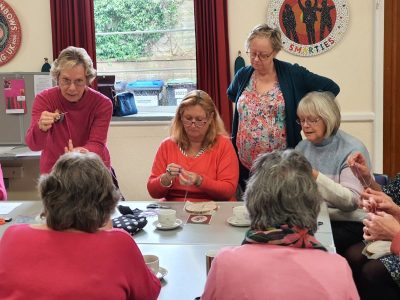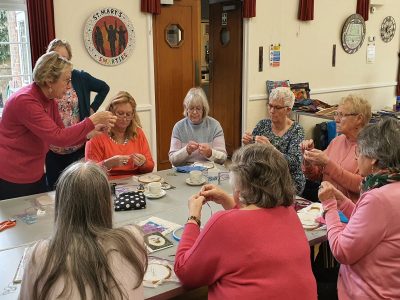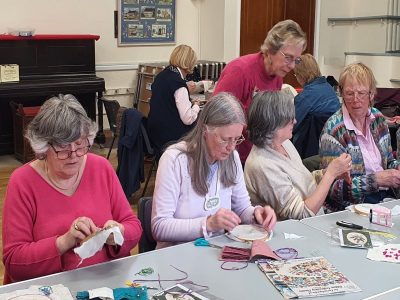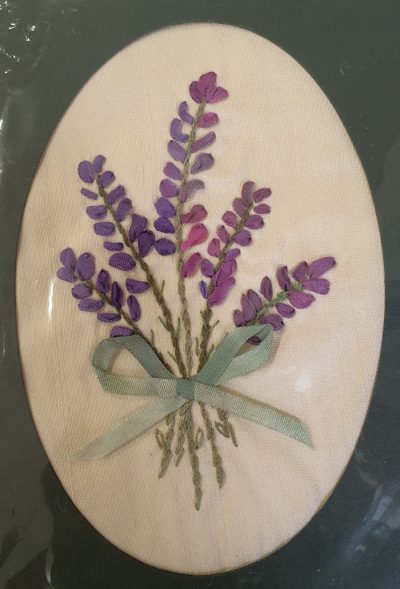 What a lovely afternoon stitching during our April sit-and-sew meeting. Jan Angove demonstrated silk-ribbon shading, and a large group of members joined her for that. Jan had hand-dyed the silk ribbon in advance, so each person’s piece will be unique. This is an example of a finished piece. There was a peaceful buzz of conversation all afternoon. Isn’t it lovely to stitch in company? There are more photos of the afternoon below. Annette reminded members that the AGM is next month, and we would like more people on the committee. It would be fine for a new committee member to join us without taking on a specific role, so that they can find out how things work before deciding if they want to take on more. One of the main things is to have new people with new ideas. The role isn’t too time-consuming; usually one committee meeting per month, and additional roles only if you want them. Don’t be put off if you’re a new member: many of us on the committee were roped in very soon after joining. We would also welcome any long-standing members who might be interested.
What a lovely afternoon stitching during our April sit-and-sew meeting. Jan Angove demonstrated silk-ribbon shading, and a large group of members joined her for that. Jan had hand-dyed the silk ribbon in advance, so each person’s piece will be unique. This is an example of a finished piece. There was a peaceful buzz of conversation all afternoon. Isn’t it lovely to stitch in company? There are more photos of the afternoon below. Annette reminded members that the AGM is next month, and we would like more people on the committee. It would be fine for a new committee member to join us without taking on a specific role, so that they can find out how things work before deciding if they want to take on more. One of the main things is to have new people with new ideas. The role isn’t too time-consuming; usually one committee meeting per month, and additional roles only if you want them. Don’t be put off if you’re a new member: many of us on the committee were roped in very soon after joining. We would also welcome any long-standing members who might be interested.
Author: Jane
Viviane’s embroidery
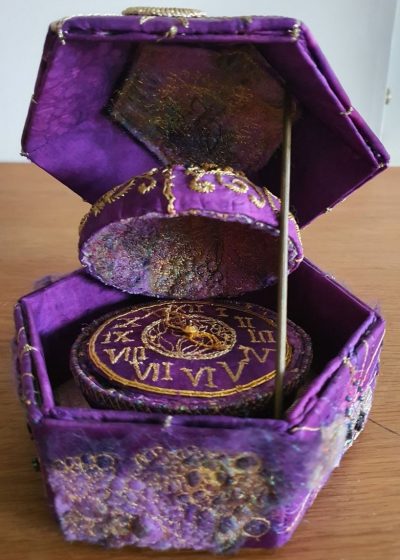 Thanks to Cobi, I have had an opportunity to photograph some of Viviane Proyer’s beautiful work at her home. The photos here give a small taste of her varied talent; her work is a feast for the eyes. The purple and gold piece show here was one of Vivian’s City and Guilds assessed pieces. Look at the detail! If you scroll to the bottom of the images, you will see a photo of the Worthing Town Panel which Viviane masterminded.
Thanks to Cobi, I have had an opportunity to photograph some of Viviane Proyer’s beautiful work at her home. The photos here give a small taste of her varied talent; her work is a feast for the eyes. The purple and gold piece show here was one of Vivian’s City and Guilds assessed pieces. Look at the detail! If you scroll to the bottom of the images, you will see a photo of the Worthing Town Panel which Viviane masterminded. 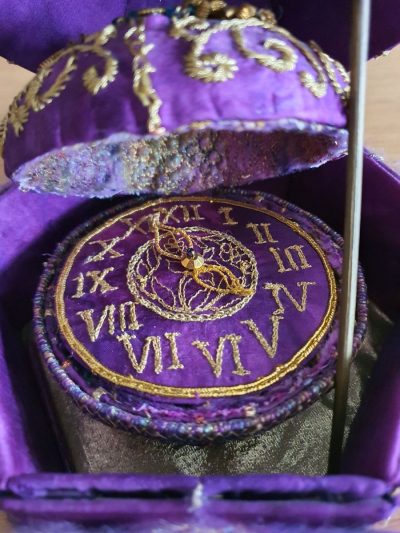

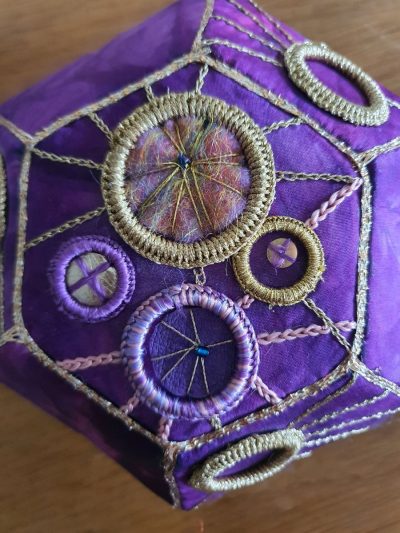
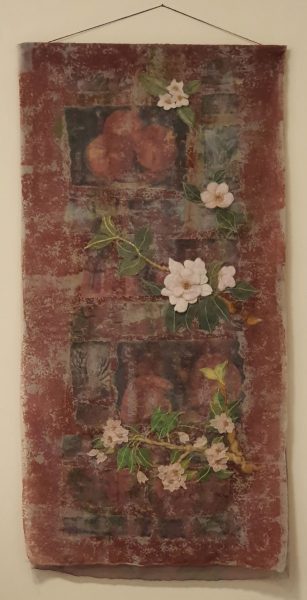



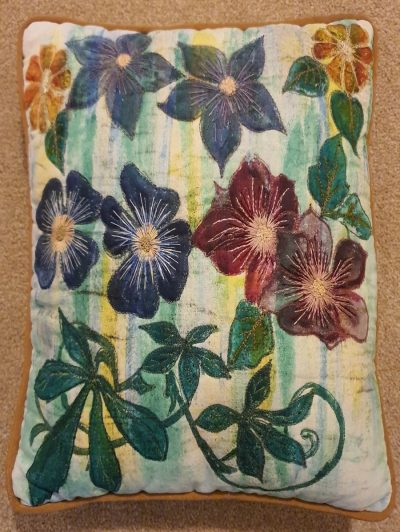 The Worthing Panel (below) can be found in the entrance of Worthing Hospital. Viviane coordinated many detailed contributions from members, which were combined into her design. There is so much detail in the panel that it deserves a whole news post in its’ own right. Photographing it during the day wasn’t very successful due to the lights in the WH Smiths shop oppositive which cast reflections on the glass (which is why it is shown here at a strange angle). I will go back another time after 8m when the shop is closed, when I hope to get some better photographs that show the details. In the meantime, here is a ‘taster’.
The Worthing Panel (below) can be found in the entrance of Worthing Hospital. Viviane coordinated many detailed contributions from members, which were combined into her design. There is so much detail in the panel that it deserves a whole news post in its’ own right. Photographing it during the day wasn’t very successful due to the lights in the WH Smiths shop oppositive which cast reflections on the glass (which is why it is shown here at a strange angle). I will go back another time after 8m when the shop is closed, when I hope to get some better photographs that show the details. In the meantime, here is a ‘taster’.
Eileen Amos
 Eileen Amos was a member of our group for many years, and members will have read this tribute to her in our newsletter, written by Jan Angove. Rather than squeeze photos of Eileen’s work into the newsletter, we thought we would put them here on the website so that members can see them at a better resolution, and remind themselves of her talent.
Eileen Amos was a member of our group for many years, and members will have read this tribute to her in our newsletter, written by Jan Angove. Rather than squeeze photos of Eileen’s work into the newsletter, we thought we would put them here on the website so that members can see them at a better resolution, and remind themselves of her talent.
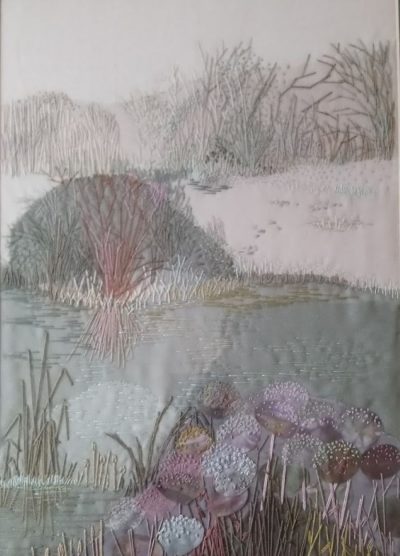 Jan wrote: I met Eileen in 1985. She ran a group “Dressmaking for the Blind” at Northbrook College. She needed an extra pair of hands so I volunteered. As our ladies had limited sight our task was to think of ways to make paper dress patterns usable by highlighting notches with textured stick on dots, checking the layout before the fabric was cut, and threading machine and hand sewing needles, as well as undoing the occasional seam! I learnt a lot about how to fit clothes from Eileen, she was a superb dressmaker. The group ran for many years and was fun as well as providing a meeting place for ladies who shared a love of sewing. The finished garments were worn with such pride.
Jan wrote: I met Eileen in 1985. She ran a group “Dressmaking for the Blind” at Northbrook College. She needed an extra pair of hands so I volunteered. As our ladies had limited sight our task was to think of ways to make paper dress patterns usable by highlighting notches with textured stick on dots, checking the layout before the fabric was cut, and threading machine and hand sewing needles, as well as undoing the occasional seam! I learnt a lot about how to fit clothes from Eileen, she was a superb dressmaker. The group ran for many years and was fun as well as providing a meeting place for ladies who shared a love of sewing. The finished garments were worn with such pride.
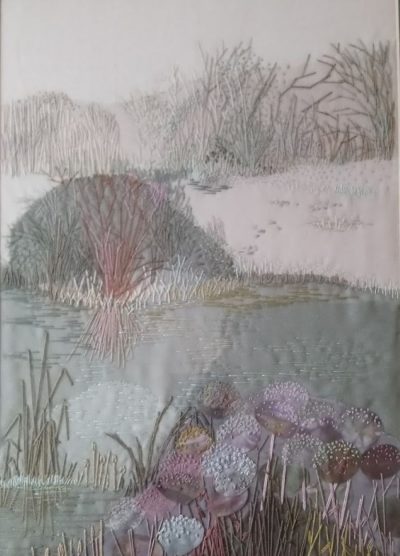 Eileen trained at Brighton College of Art, and then taught dressmaking at Tunbridge Wells College of Art before the family moved to Rustington.
Eileen trained at Brighton College of Art, and then taught dressmaking at Tunbridge Wells College of Art before the family moved to Rustington.
 She made some of the examples of sewing techniques for books on dressmaking produced by Ann Ladbury in conjunction with her TV series in the 70’s. Sarah, Eileen’s daughter says she and her sister Karen modelled some of the children’s clothes Eileen made for Woman and Home magazine. There were many clients for whom Eileen would make beautiful clothes. She also made garments for the weaver Geraldine St Aubyn Hubbard, a textile artist based near Chichester. The cloth (silk, cashmere and wool) was woven, then passed to Eileen who made it into loose fitting couture garments destined for London boutiques. This partnership lasted many years.
She made some of the examples of sewing techniques for books on dressmaking produced by Ann Ladbury in conjunction with her TV series in the 70’s. Sarah, Eileen’s daughter says she and her sister Karen modelled some of the children’s clothes Eileen made for Woman and Home magazine. There were many clients for whom Eileen would make beautiful clothes. She also made garments for the weaver Geraldine St Aubyn Hubbard, a textile artist based near Chichester. The cloth (silk, cashmere and wool) was woven, then passed to Eileen who made it into loose fitting couture garments destined for London boutiques. This partnership lasted many years.
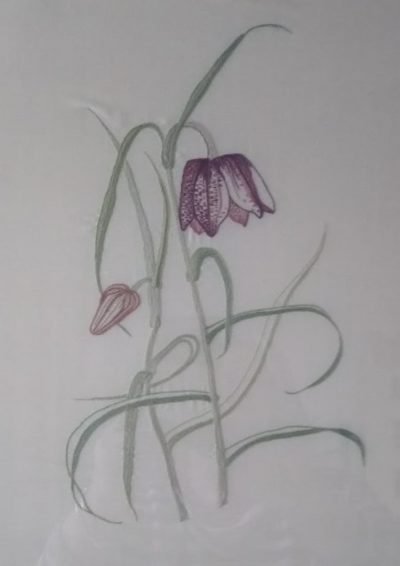 After Eileen gave up some of her dressmaking she turned to hand and machine embroidery on silk which she had painted, producing exquisite pictures and bags. She was a member of the Embroiderer’s Guild for many years, and of Pizazz and exhibited with them. Eventually mobility issues meant she had to give up attending meetings.
After Eileen gave up some of her dressmaking she turned to hand and machine embroidery on silk which she had painted, producing exquisite pictures and bags. She was a member of the Embroiderer’s Guild for many years, and of Pizazz and exhibited with them. Eventually mobility issues meant she had to give up attending meetings.
Over the years I kept in touch with Eileen and we would meet occasionally for coffee and a chat about all things “sewing”.
Jan Angove
Batik talk by Rosi Robinson
 Thank you to Maria who wrote this description of the talk given by Rosi Robinson at our March meeting.
Thank you to Maria who wrote this description of the talk given by Rosi Robinson at our March meeting.
On Tuesday 14th March Rosi gave us a very comprehensive talk about her work as a batik artist, teacher, lecturer and author. She retired from teaching in 2013 and now lectures and teaches batik workshops throughout the world. Rosi is a member of the Sussex Guild, the Batik Guild and Craft Nova Scotia Canada. In 2022 Rosi was filmed in her studio for a feature on Bargain Hunt when they were filming at the Ardingly Antiques Fair. They filmed for two and a half hours for a four minute slot. Following the exposure on National TV Rosi was inundated with over 60 orders for her work.
 Rosi told us that batik is a traditional resist technique of decorating fabric where wax is applied to white fabric to resist colourful dyes. She uses this technique to produce pictures that are often mistaken for watercolour paintings. Rosi started her talk by showing various batiks collected from around the world and explaining the various techniques used. As these were then passed around the room there was a “buzz” as everyone touched and discussed the various fabrics.
Rosi told us that batik is a traditional resist technique of decorating fabric where wax is applied to white fabric to resist colourful dyes. She uses this technique to produce pictures that are often mistaken for watercolour paintings. Rosi started her talk by showing various batiks collected from around the world and explaining the various techniques used. As these were then passed around the room there was a “buzz” as everyone touched and discussed the various fabrics.
 Rosi then demonstrated the technique by applying hot wax to fabric which works as a resist. She demonstrated different waxing tools such as cantings (tjantings), brushes and caps (tjaps). She then painted on the dyes. The waxed areas resist the dye and remain the original colour. Only unwaxed areas take up the dye. Start with the lightest colours, gradually building up the tones to the darker colours. The fabric has to dry before the next layer of wax is added. Once completed a hot iron is used to remove most of the wax and the item is then boiled or dry cleaned.
Rosi then demonstrated the technique by applying hot wax to fabric which works as a resist. She demonstrated different waxing tools such as cantings (tjantings), brushes and caps (tjaps). She then painted on the dyes. The waxed areas resist the dye and remain the original colour. Only unwaxed areas take up the dye. Start with the lightest colours, gradually building up the tones to the darker colours. The fabric has to dry before the next layer of wax is added. Once completed a hot iron is used to remove most of the wax and the item is then boiled or dry cleaned.

Rosi then shared a slide show of lots of stunning examples of her own work.
Several members have already attended a workshop with Rosi and others have expressed an interest in attending one. We will be looking at options for 2024.
Embroidered hearts
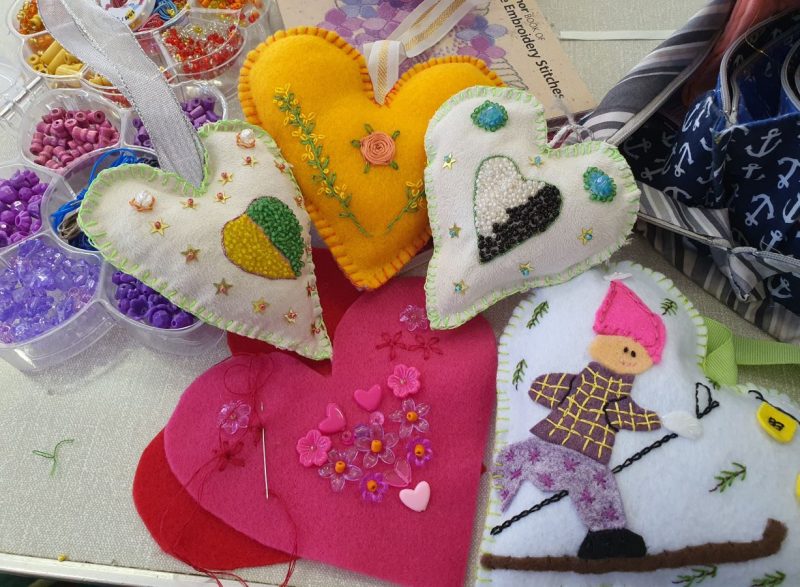 Thank you to Pam for helping people to make embroidered hearts during our February sit-and-sew. Felt, threads and beads were provided by the committee, and anyone who wanted to join in could use Pam’s template to make a heart to their own design. There were some lovely works in progress.
Thank you to Pam for helping people to make embroidered hearts during our February sit-and-sew. Felt, threads and beads were provided by the committee, and anyone who wanted to join in could use Pam’s template to make a heart to their own design. There were some lovely works in progress.
 The hand-stitch table was introduced in sit-and-sew sessions from the December meeting. This followed feedback from several people who had said that they weren’t sure what to work on for the afternoon sessions, including people who are beginners or feel a bit ‘rusty’ on their stitching, and also experienced people who appreciate a new idea to work on. We plan to have something similar at other sit-and-sew sessions. We would welcome ideas for subjects that would be suitable to do in an afternoon session and that don’t require much in the way of materials or preparation. If you would be willing to help beginners in this informal setting, please let a committee member know. Encouraging each other is what SCS is all about.
The hand-stitch table was introduced in sit-and-sew sessions from the December meeting. This followed feedback from several people who had said that they weren’t sure what to work on for the afternoon sessions, including people who are beginners or feel a bit ‘rusty’ on their stitching, and also experienced people who appreciate a new idea to work on. We plan to have something similar at other sit-and-sew sessions. We would welcome ideas for subjects that would be suitable to do in an afternoon session and that don’t require much in the way of materials or preparation. If you would be willing to help beginners in this informal setting, please let a committee member know. Encouraging each other is what SCS is all about.



 We were amazed by the stitched 3D pheasant that Gay made in the Mixed Media group. Caroline, Maria and Jane B led a couple of sessions making 3D creatures, and it’s interesting to see what different directions people took the project in. I hope Gay will forgive me for putting a couple of photos here. He is too magnificent not to be shown!
We were amazed by the stitched 3D pheasant that Gay made in the Mixed Media group. Caroline, Maria and Jane B led a couple of sessions making 3D creatures, and it’s interesting to see what different directions people took the project in. I hope Gay will forgive me for putting a couple of photos here. He is too magnificent not to be shown!
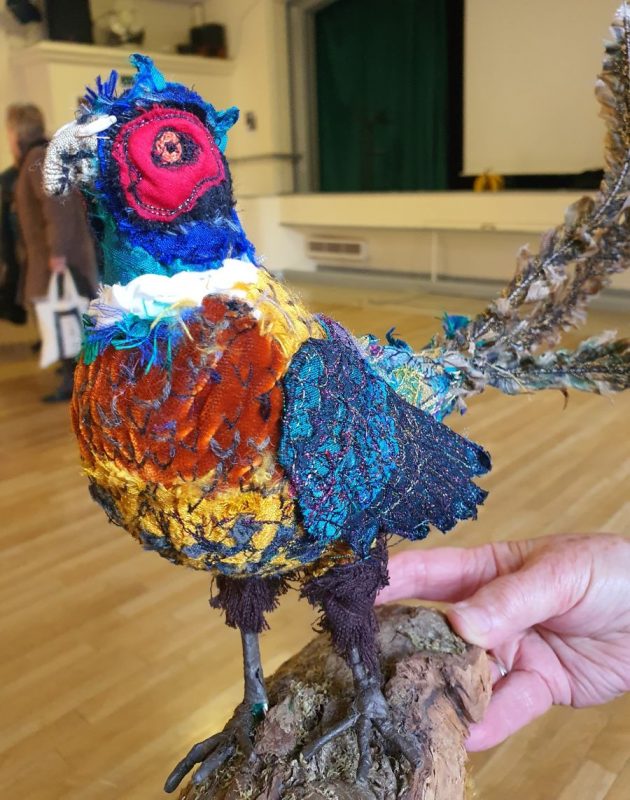
Viviane Proyer
 Members will have read the testimonial to Viviane in the recent newsletter, written by her good friend Linda Hoddy, and a previous news post on this website which included Viviane’s own description of her textile journey. The committee would also like to acknowledge the important contribution that Viviane made to the development of our group. Today, the day of her funeral, seems a good day to share this.
Members will have read the testimonial to Viviane in the recent newsletter, written by her good friend Linda Hoddy, and a previous news post on this website which included Viviane’s own description of her textile journey. The committee would also like to acknowledge the important contribution that Viviane made to the development of our group. Today, the day of her funeral, seems a good day to share this.
Viviane was a long-standing member of our group, and had a great influence on our history. The photo in the previous news post shows Viviane with other friends and colleagues who have also made great contributions to our group (left to right: Anne Turner, Viv Scrase, Linda Hoddy, Elaine Blaney and Viviane).
Viviane joined the group many years ago and she became a committee member, then Chairman. She was also our local ‘President’ of the Embroiderers Guild for many years. Viviane was very influential in setting up the Embroiderers Guild Regional Committee, which acted as a communication channel between different groups across our area and organised regional activities. The former ‘Region’ is still going strong (as Stitch Together) and organises things like online courses and summer-schools, so Viviane’s influence extended beyond the end of the Embroiderers Guild. Viviane was always a passionate advocate for the EG, and always encouraged members to think about the positive things that the EG did, for example in preserving the textile collection. At our meeting in November 2018, she gave a talk to members on the history of the Embroiderers Guild, describing the origins of the national organisation and the local branches. Viviane was very disappointed when the national Embroiderers Guild and the local branches ‘parted company’, as she had always believed that the national guild and the local branches were good allies. Despite this, she stayed involved and enthusiastic when we re-formed as the new SCS group.
In 1998 Viviane was asked to stitch a new pennent for the Worthing Mayoral car and in 1999 she was asked to stitch a new flag for the car, both of which she did on behalf of the Embroiderers Guild. The photos here show the Mayor thanking Viviane for her work, a newspaper article, and the pennant.


Viviane organised and oversaw the creation of the Worthing Hospital embroidered panel, which I believe can still be seen in the hospital today. The collaboration and camaraderie that was created by making the panel turned into a long-term group, which became the Thursday workshop which is still going strong. We are hoping that Cobi can share details with the group of how it was designed and made.
Viviane was an accomplished embroiderer, who combined traditional skills with more contemporary approaches. It would be nice to show some of her work here, so if anyone has any photos they could send us that would be much appreciated.
Grandmother’s kitchen
 Members will have heard by now about the sad loss of Viviane Proyer, a long-term member of our group and good friend to many. There is a tribute to Viviane in our newsletter for members. In addition, we would like to share some words here that were written by Viviane herself, describing her journey into embroidery. Viviane is pictured here during our 40th anniversary celebrations, with others who have also all had an influence on our group. Left to right: Anne Turner, Viv Scrase, Linda Hoddy, Eileen Blaney, with Viviane on the right.
Members will have heard by now about the sad loss of Viviane Proyer, a long-term member of our group and good friend to many. There is a tribute to Viviane in our newsletter for members. In addition, we would like to share some words here that were written by Viviane herself, describing her journey into embroidery. Viviane is pictured here during our 40th anniversary celebrations, with others who have also all had an influence on our group. Left to right: Anne Turner, Viv Scrase, Linda Hoddy, Eileen Blaney, with Viviane on the right.
MEMORIES WRITTEN BY VIVIANE
Godmothers Kitchen and Making do and Mending
I was born in Switzerland and lived there until I was 19, so my upbringing was in that country and it was there that my early experiences of stitching and knitting took place.
I was brought up with my maternal grandmother who had a great influence on my use of the needle. She had seven children and with a growing number of grandchildren she was deft at making something out of “nothing”. She was always making little presents for us all with remnants, embellishing the various items with crochet and embroidery. Perhaps this was the beginning of my love of “remnants”, always looking in the tubs, the fabric shops, always finding something that can be used later.
During the war the Government issued wool packs to be distributed to schools and organisations asking for socks to be knitted for soldiers in the Army. As a very young girl I knitted a pair with my aunts help. This was good training for later in my married life as my husband loved hand knitted socks. I somehow enjoyed doing the heel best as this took away the boredom of the straight bit!
At school we were taught to “mend” all manner of things. So, we mended, neatly patching and adding new pieces to sheets, shirts etc. and sometimes using the tail of a shirt to make a new collar. We learned to do all manner of seams, plain seam, French seam. felled seam. Mending was an art in itself.
Whilst we stitched in class, we had a practice of someone reading a book out loud, taking turns. Usually a pupil, well advanced in her work, would have the privilege to read in class. I enjoyed both stitching and reading and often found myself sitting on a desk, perched above the others, reading away. Wonderful!
It was the practice in Switzerland for every girl to prepare her “trousseau”. A list was made of the required items. There was a standard list, all made in good cotton or linen, whatever you could afford. Specialist firms existed producing such quality fabrics. Once bought, all the pieces were initialled with embroidery and sometimes embroidered with very intricate patterns. These items were to last a lifetime.
As I grew older, we used to spend the winters evenings in my Godmothers kitchen cosy with the warmth of the Aga, a big lamp on the round table and there we would stitch, making tablecloths for the local fete. It was heaven. We chatted away, sometimes listening to the radio – a play or a concert. These were really lovely and peaceful evenings – and no television.
Then I married, had children and my husband (very wise person) bought me my first sewing machine, my very own…and all the skills learned in my childhood had to be put to the test. Money was short and I remembered my grandmother making do, using old to make new. I became very inventive, trying all kinds of mix and match…decorating dull little dresses, learning to smock, knitting intricate patterns for boy’s jumpers. All had to be different. But I never knitted stockings for my daughter. I had this awful memory of the scratchy wool used for one pair of stockings my mother made me. Horrid.
I always was grateful for the early teaching I received. I know I was then good at it and enjoyed it, but it was even better when later on, much later on, when I retired, to be able to throw the boundaries to the wind and be really creative. And the discovery of the Embroiderers Guild opened an entirely new vista.
Another article written by Viviane
I have always been able to stitch, but it was mostly for practical purposes. I consider myself a late developer as I got into the creative side of stitching when I retired. I met Ken DeDenne whose sister was a doyenne of the Embroiderers Guild and he encouraged me to take a City and Guilds course in Harrow. I did two years then we moved to Sussex, and I continued in Fareham. I never looked back.
I took a year’s course with Jane Lemon “Ecclesiastic Embroidery” which was wonderful and has been very useful when asked to do some throws and stoles for the Chapel in the newly built hospital in Worthing. I am an all-rounder, being interested in all kinds of embroidery and like working with paper too. I love attending courses to give more variety in my creativity. Basically, I enjoy all manner of Textile orientated creative work. I also enjoy passing on to others my knowledge and promote all textile activities.
PRAYER
This is a prayer sent to the Scene South East Regional magazine by Viviane in May 2020. Very appropriate now.
GOD GRANT THAT I MAY SEE THE STITCH
UNTIL MY DYING DAY
AND WHEN MY LAST SHORT THREAD IS CLIPPED
AND SCISSORS TUCKED AWAY
THE WORK THAT I HAVE DONE LIVE ON
THAT OTHER FOLK MAY SEE
THE PLEASURE I HAVE KNOWN, LORD
IN THE SKILL YOU GAVE TO ME.
RIP Viviane.
‘Those who understand, teach’.

Thank you to Amanda Duke for an interesting and entertaining talk at our January meeting. Amanda was an art teacher for many years and was head of art at Steyning Grammar School. The focus of her talk was debunking the claim by George Bernard Shaw that ‘Those who can, do; those who can’t, teach’. During her talk, Amanda spoke about the transition from teacher to full-time artist, and the process of building confidence in both. Amanda spoke about how fortunate she felt to have good art teaching herself as a student, and how passionate she feels about passing this on. There are quite a few teachers in our group, so there were many nodding heads as Amanda talked.

Amanda talked us through her lifetime of ‘Art Doing’ and ‘Art Teaching’. Starting with a fine art training, becoming a teacher for 36 years including being head of art; and only fairly recently (the last few years) becoming a full-time artist. Her practice has mainly been in fine art and collage, and it is mainly the last five years or so that she has become a textile artist. It was surprising (and strangely reassuring) to hear Amanda talk about Imposter Syndrome as an artist in her own right. This isn’t something that you expect to hear from someone who is art college trained, taught art for 36 years, produces such amazing work, has won a prize at the Festival of Quilts, been an exhibitor with different prestigious exhibiting groups, set up and run two large exhibitions at the FOG and other achievements. If someone feels this despite having such clearly established professional art credentials, then there is hope for the rest of us! In fact that was one of the main themes of Amanda’s talk – how to find the courage to just get on and do it, take a risk, and ‘put yourself out there’.
 Stitched textiles are a relatively new departure for Amanda, whose main interests until a few years ago had been in fine art, and paper collage. An interest in stitch and quilting began to develop when she facilitated the Steyning Grammar School Heritage Quilts. This was a project that was supported by a Heritage Lottery grant, and was a community project that brought in 500 local people of all ages. It led to setting up the ‘Steyning So and Sews’, when the group had enjoyed themselves so much that they didn’t want to stop when the project was completed.
Stitched textiles are a relatively new departure for Amanda, whose main interests until a few years ago had been in fine art, and paper collage. An interest in stitch and quilting began to develop when she facilitated the Steyning Grammar School Heritage Quilts. This was a project that was supported by a Heritage Lottery grant, and was a community project that brought in 500 local people of all ages. It led to setting up the ‘Steyning So and Sews’, when the group had enjoyed themselves so much that they didn’t want to stop when the project was completed.
 In 2014 Amanda went part-time at school and started teaching adults too. Over the last four or five years, Amanda has been increasingly drawn to fabric and stitch. Like many SCS members she did a course with Wendy Dolan, which gave her the skills to machine-embroider over her fabric collages. Being Artist in Residence at Sussex Prairie Gardens in 2017 encouraged her to think big, and she was inspired by the flowers and leaves, as well as the experience of ‘meandering’ through the paths and flower-beds. She developed techniques and skills in plant-rubbings and eco-print, which she incorporated into the exhibition.
In 2014 Amanda went part-time at school and started teaching adults too. Over the last four or five years, Amanda has been increasingly drawn to fabric and stitch. Like many SCS members she did a course with Wendy Dolan, which gave her the skills to machine-embroider over her fabric collages. Being Artist in Residence at Sussex Prairie Gardens in 2017 encouraged her to think big, and she was inspired by the flowers and leaves, as well as the experience of ‘meandering’ through the paths and flower-beds. She developed techniques and skills in plant-rubbings and eco-print, which she incorporated into the exhibition.
 Being the artist-leader on a Colouricious holiday to India threw Amanda into a full sensory experience, and in response her work moved away from the more subtle browns and greens and became a riot of colour. She moved to using Procion-dyed fabrics rather than natural-dyes, and enjoyed the vibrant colours that these produce.
Being the artist-leader on a Colouricious holiday to India threw Amanda into a full sensory experience, and in response her work moved away from the more subtle browns and greens and became a riot of colour. She moved to using Procion-dyed fabrics rather than natural-dyes, and enjoyed the vibrant colours that these produce.

Amanda joined Leslie Morgan at the Committed to Cloth studio, and felt she had found ‘her tribe’. She enjoyed the sense of purpose, productivity and play, which in turn she passes on to her own students. Unfortunately this was around the time of Covid lockdowns, so Amanda was then suddenly working on her own in her garden studio, and having to think about what direction she wanted to go in. Over time she began to draw together her two quite different styles of work – the natural dye processes and the Procion dye processes. Spending lockdown time in her garden led to realising that the reason the flower colours ‘pop’ and look so bright is that they are offset by the more neutral colours of leaves and earth. This led her to combine the two styles together.
 Having been invited to exhibit at the Festival of Quilts, Amanda found herself taking responsibility for the gallery since the founder of the group was unwell. This was a very big learning curve. At the same FOQ she also entered one of her quilts to the open competition and was delighted to win a prize (anyone who has been to the FOQ will know what an achievement this is). Amanda described the combination of excitement, nerves and achievement that this experience gave. She encouraged everyone to seize opportunities and ‘go for it’.
Having been invited to exhibit at the Festival of Quilts, Amanda found herself taking responsibility for the gallery since the founder of the group was unwell. This was a very big learning curve. At the same FOQ she also entered one of her quilts to the open competition and was delighted to win a prize (anyone who has been to the FOQ will know what an achievement this is). Amanda described the combination of excitement, nerves and achievement that this experience gave. She encouraged everyone to seize opportunities and ‘go for it’.

Amanda has largely seen off any ‘Imposter Syndrome’ now that she has been able to develop her own practice and has seen that people respond to her work. However, she is passionate about encouraging other people to learn and enjoy art and textiles, and remains a teacher at heart. She is also now able to confidently describe herself as ‘An artist’. Her story brought her talk back to the original sneer that ‘Those who can’t, teach’ and highlights the much better quote from Aristotle that ‘Those who know, do: Those who understand, teach’.





